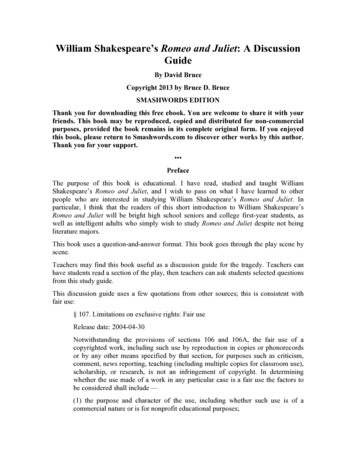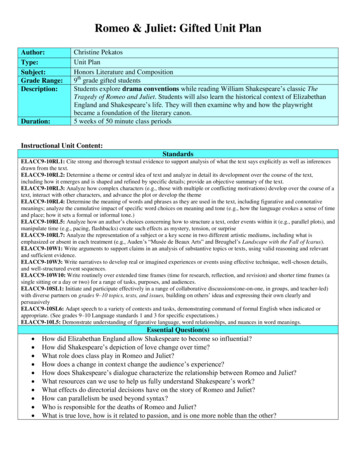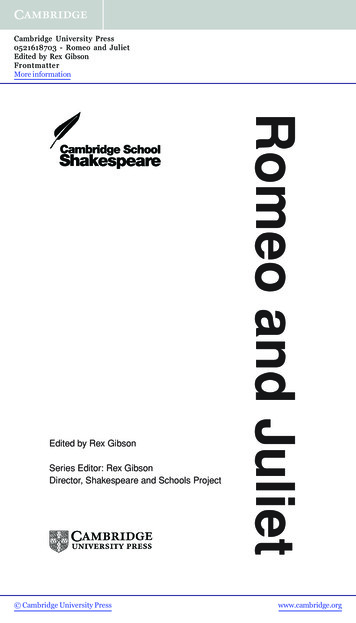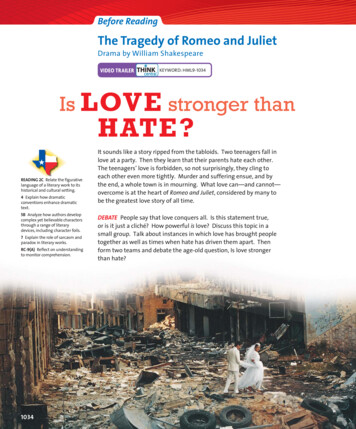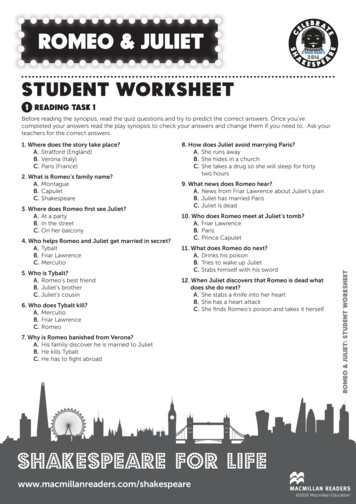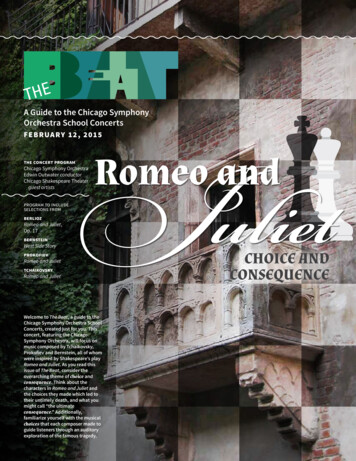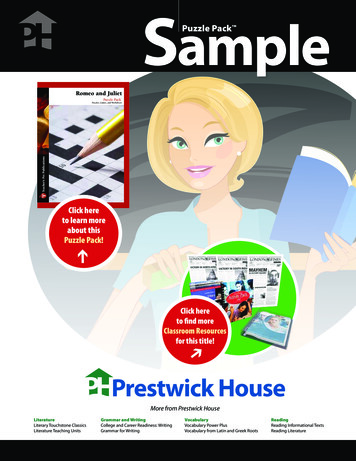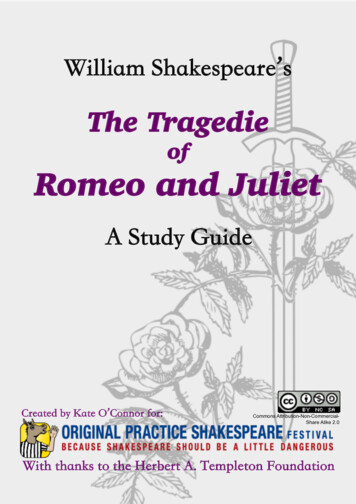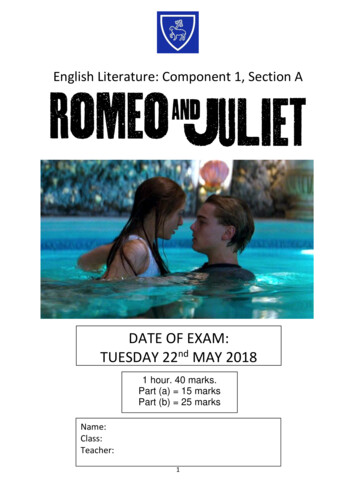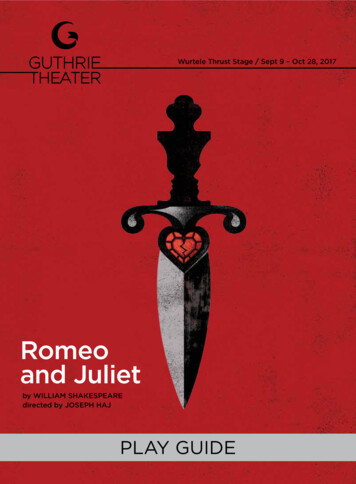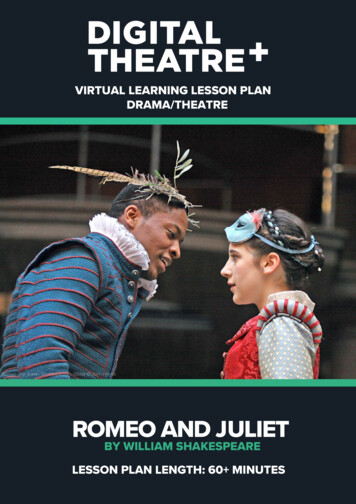
Transcription
VIRTUAL LEARNING LESSON PLANDRAMA/THEATRERomeo and Juliet - Shakespeare's Globe John HayesROMEO AND JULIETBY WILLIAM SHAKESPEARELESSON PLAN LENGTH: 60 MINUTES
LESSON PLANROMEO AND JULIETLEARNING OBJECTIVESBy the end of this lesson, students will be able to: Understand characters and their motivations through script analysis and observation Analyse how character relationships assist in telling the story Demonstrate how language devices are used to create meaning in the text Compare and contrast multiple interpretations of the same text and consider how artisticchoices create meaning Apply skills to develop a character and perform their own interpretation of the BalconyScene (Act 2, Scene 2).To teach this lesson, you will need the following resources: Romeo and Juliet Shakespeare’s GlobeRomeo and Juliet Royal Shakespeare CompanyRomeo and Juliet Study Guide - Language DevicesRomeo and Juliet Study Guide - Speaking the TextCompare and Contrast Choices GuidePlus: Electronic copies of Act 2, Scene 2Pens and paper or access to Microsoft Word or equivalentHighlighters - two different colours (pink and yellow)Access to video conferencing or shared documents (e.g. Google Docs)*Further viewing: Star Cross’d: A Contemporary Take on Shakespeare’s Romeo and Juliet*Keeping students and teachers safe during remote education is essential. Please ensure anyonline platform you are using to communicate or coordinate with students is suitable for theirage group and check privacy settings. For further information, see the NSPCC guidance.For further resources to help you teach Romeo and Juliet, including a full-lengthproduction, and study guide, visit www.digitaltheatreplus.com
LESSON PLANROMEO AND JULIETEXERCISE 1ANCIENT GRUDGESetting the scene: Provide students with the link to the Shakespeare’s Globeversion of Romeo and Juliet. Instruct them to navigate to Act 1, Scene 5 (0:30:30-0:35:15),where Romeo and Juliet meet for the first time at theCapulet Ball.ESTIMATED TIME:10 MINUTESThe aim of this exercise is to givestudents an entry point to theplay, to explore broad themesand subtext, and to help themmake connections between theirown contexts and the world ofthe play. During this scene, two ‘star-crossed’ lovers have just met ata party and it was love at first sight. The attraction is mutual,but they’re from two feuding families with an ancientgrudge.Assignment/Discussion: Create a spider diagram/list of what this ancient grudge might be:ooo As an individual activity, students can complete this work and share itdirectly with you.If your class is able to meet virtually, you could discuss it together.If you are using a shared document such as Google Docs, students couldadd their thoughts and ideas as well as respond to others within thedocument.Share some contemporary examples of long-established rivalries. This can becompleted using the same suggestions above - either doing the work individuallyor as a group.For further resources to help you teach Romeo and Juliet, including a full-lengthproduction, and study guide, visit www.digitaltheatreplus.com
LESSON PLANROMEO AND JULIETEXERCISE 2ESTIMATED TIME:WHEN WE MEET AGAIN Pair students up and assign one to be Romeo and theother to be Juliet. Using any chat option available (Zoom, Google Hangouts,WhatsApp etc.) ask the students to write a series ofmessages to each other in character - each student mustwrite at least five messages/responses.10 MINUTESThe aim of this exercise is forstudents to use their knowledge ofRomeo and Juliet to improvisetext and manipulate elements ofdrama to convey the psychologicalaspects (thoughts and feelings) oftheir characters. The content of the messages should be what Romeo andJuliet would say to each other after the Balcony Scene how would that conversation continue? Ask the students to screenshot their message thread and send to you. Students should then choose another member of the class to serve as theirconfidante. They should write a message to this friend describing the person they justmet. Again, ask students to screenshot their messages and send to you. You can share some of the conversations with the class in your online learningenvironment.For further resources to help you teach Romeo and Juliet, including a full-lengthproduction, and study guide, visit www.digitaltheatreplus.com
LESSON PLANROMEO AND JULIETEXERCISE 3WATCH SCENE Provide students with a link to the Shakespeare's Globeversion of Romeo and Juliet. Instruct them to watch a section of Act 2, Scene 2(0:45:04-0:50:30), where Romeo goes to visit Juliet at herhouse.ESTIMATED TIME:10 MINUTESThe aim of this exercise is toevaluate part of the production,delve further into the centralcharacters and their psychology,and provide rationale for artisticchoices.Responses Before watching the scene, students should prepare two sheets of paper or twodocuments online: one labelled ROMEO and the other labelled JULIET. As they watch the scene, students should write down words to describe eachcharacter on their named page. Ask students to watch the scene a second time and record evidence/rationale forthese words - citing specific moments and text whenever possible. The work should be completed individually and turned in to you.Extension Activity/Option: Have a virtual class meeting where the words and evidence can be shared anddiscussed as a group.For further resources to help you teach Romeo and Juliet, including a full-lengthproduction, and study guide, visit www.digitaltheatreplus.com
LESSON PLANROMEO AND JULIETEXERCISE 4ESTIMATED TIME:CLOSE TEXTUAL ANALYSISProvide your students with the following: A digital extract of the Balcony Scene: from Romeo “Butsoft!” to Juliet “ be a Capulet.” Links to or copies of Speaking the Text and LanguageDevices from the Study Guide for students to refer todefinitions and examples.Ask students to download and print* the text in order tomark their script as follows:15 MINUTESThe aim of this exercise is to buildon the previous task by havingstudents apply their learning to anannotation task. Students willdemonstrate their understanding oflanguage by analysing the text indetail. Students will then analyseand evaluate two contrastingcaptured productions, andinvestigate how language andliterary devices are used in thetext.Circle the end word on each lineHighlight examples of assonance in pinkHighlight examples of rhyme in yellowPut a star next to any lines with 11 beats – or lines which donot adhere to the traditional form of iambic pentametero Underline the Os and Ahs.oooo*If a student is unable to download and print the text, they can mark it in an online program such as GoogleDocs or Microsoft Word. All noted markings can be done in these programs, though you can make whateveradjustments are necessary to work for you.Watch: Provide students with the link to watch the Royal Shakespeare Company's (RSC)contemporary staging of Romeo and Juliet and direct them towards Act 2, Scene 2(0:37:38-0:42:45). Ask them to listen intently to how the actors interpret the scene, specifically how theyperform the language using rhythm, dynamics, actor-audience relationship and space.Reflection: If you are able to meet in a virtual environment, discuss the interpretation based on thekey points identified in the script. If you cannot meet virtually, ask students collaborate inpairs to answer the prompts below and turn the responses into you.oooooLooking only at the end words, what clues do we get to the subtext?Discuss the effect of assonance in this scene.Discuss the effect of rhyme in this scene.Identify and discuss examples of iambic pentameter and 11-beat lines.Discuss the heightened language in the scene – Os and Ahs.For further resources to help you teach Romeo and Juliet, including a full-lengthproduction, and study guide, visit www.digitaltheatreplus.com
LESSON PLANROMEO AND JULIETCompare and contrast:Compare and contrast the contemporary RSC version to the traditional Globe versionwatched earlier, and answer the final questions in our Compare & Contrast Choices Guide:1.Which performance did you prefer and why?2. What specific differences did you observe? Share your opinions on the decisionsmade and why they were chosen for that specific production.3. Did you notice anything missing from either of the performances? Has the textbeen altered for the specific interpretation? If so, what effect did this have?There are many questions in the Compare & Contrast Choices Guide which you couldchoose to include in addition to these three final questions.For further resources to help you teach Romeo and Juliet, including a full-lengthproduction, and study guide, visit www.digitaltheatreplus.com
LESSON PLANROMEO AND JULIETEXERCISE 5PERFORMING & EVALUATINGPerformingIn pairs, students will rehearse and perform Act 2, Scene 2virtually using video conferencing. As Romeo and Juliet werenot in the same space, this scene will work well in the virtualenvironment.ESTIMATED TIME:20 MINUTESThe aim of this exercise is toperform scripted drama and makedeliberate artistic choices to createdramatic meaning. Students willalso evaluate their work. Initial script analysis - have students identify the givencircumstances, and a key motivation of each character. Read through the scene in pairs. Incorporating all of the research and discoveries made during this lesson, rehearsetheir interpretation of the Balcony Scene and prepare for performance. Pairs then work together to decide how to present their scene, for example:o Record a FaceTime or Zoom callo Record their videos separately and edit together. Have students perform and record their scene and then share that recording withyou. If possible, you can publish the scenes onto your chosen virtual platform for othermembers of the class to see.EvaluatingStudents should then reflect on and evaluate their own performance in their journal. Youmay choose to have students send their journal entry to you.If you are able to publish the recordings for the entire class to see, ask students to respondanonymously to at least one other performance as well .For further resources to help you teach Romeo and Juliet, including a full-lengthproduction, and study guide, visit www.digitaltheatreplus.com
For further resources to help you teach Romeo and Juliet, including a full-lengthproduction, and study guide, visit digitaltheatreplus.comWant more resources to support your teaching? Discover thousands of engaging lessonmaterials from Digital Theatre . Explore some of our most popular content by clicking thelinks below.The CrucibleBy Arthur MillerOld Vic ProductionStudy GuidePractical GuideArthur Miller Concise IntroductionArthur Miller DocumentaryHamletBy William ShakespeareRoyal Shakespeare Company ProductionPractical Workshop GuideStudy GuideHamlet Soliloquy Compare and ContrastAntigoneBy SophoclesBBC ProductionPractical Workshop GuideStudy GuideTeaching Antigone with Digital Theatre MacbethBy William ShakespeareEveryman Theatre ProductionStudy GuideManga ShakespeareShakespeare In Your Space WorkshopAnd more!
STUDY GUIDEROMEO AND JULIETLANGUAGE DEVICESRHYMINGThis one’s easy. Two or more different words that sound the same.MERCUTIOWhat eye but such an eye would spy out such a quarrel?(ACT 3, Scene 1).REPETITIONAgain, pretty straightforward.MERCUTIOA bawd, a bawd, a bawd!(ACT 2, Scene 4).ALLITERATIONWhen a row of words starts with the same letter such as this line of Romeofrom Act 2, Scene 4. When Romeo is taking the mickey out of Mercutio hecould use this run of 's's in this line.ROMEOO single soled jest, solely singular for the singleness.(Act 2, Scene 4).ASSONANCEWhen the vowel sounds of two non-rhyming words rhyme, such as this linefrom one of the Nurse's speeches.digitaltheatreplus.com
STUDY GUIDEROMEO AND JULIETNURSEI am none of his skains mates.(Act 2, Scene 4).DISSONANCEWhen the sounds of two words clash violently on the ear, so as to heightenboth.MERCUTIODido a dowdy.(Act 2, Scene 4)PARADOXA more complicated idea. A paradox is an idea that has sound (orapparently sound) reasoning but leads to a conclusion that makes nosense or is self-contradictory. For example, to walk from the centre of aroom to the wall I would have to go half the distance, but I would still havehalf the distance to travel. From that point I would still have half thedistance to travel again. And so on and so on. I would always still have ahalf a distance to travel to the wall, ergo theoretically I would never reachthe wall. Which is nonsense because I would. Paradoxes are often used tomake an intellectual point, or to simply bamboozle.ANTITHESISOpposites. On the one hand this, and on the other hand that. The weighingup of two ideas. The setting of one idea against another to work out abigger problem. The most famous example is of course Hamlet’s line “Tobe or not to be ”. The thoughts in Shakespeare’s prose are oftenexpressed antithetically. Antithesis can be comic as well as dramatic.digitaltheatreplus.com
STUDY GUIDEROMEO AND JULIETPETERBut I am sent to findthose persons whose names are here writ, andcan never find what names the writing person hathhere writ. (Act 1, Scene 2)OXYMORONA contradiction in terms. A tall dwarf. A white raven. An honest politician. Amodest footballer. Shakespeare’s characters often revel in a goodoxymoron.MERCUTIOThy wit is a very bitter sweeting.(Act 2, Scene 4).LISTSThe three-part list is one of the most famous rhetorical devices. JuliusCaesar’s famous quotation “Veni, Vidi, Vici” or “I came, I saw, I conquered”.A more prosaic example is Tony Blair’s “Education, Education, Education”.What impact does a three-part list have upon the listener?MERCUTIOWhy, is not this a lamentable thing,grandsire, that we should be thus afflicted with grandsire, that weshould be thus afflicted withthese strange flies, these fashionmongers,these pardon-me's. (Act 2, Scene 4)digitaltheatreplus.com
STUDY GUIDEROMEO AND JULIETThere are other rhetorical devices, too, but use this list as a rule of thumband you can’t go far wrong. The main thing, when reading these speeches,is to identify the rhetorical devices and use them, relish them, enjoy them,just as the character does. Remember they should always be played asself-conscious choices by the character. The following prose speech isfrom the play, can you spot all of the rhetorical devices in it? When you’vefound them read the speech aloud and see how it feels to speak comparedwith just a flat reading MERCUTIOThe pox of such antic, lisping, affectingfantasticoes; these new tuners of accents! 'By Jesu,a very good blade! a very tall man! a very goodwhore!' Why, is not this a lamentable thing,grandsire, that we should be thus afflicted withthese strange flies, these fashion-mongers, theseperdona-mi's, who stand so much on the new form,that they cannot at ease on the old bench? O, theirbones, their bones!(Act 2, Scene 4)digitaltheatreplus.com
STUDY GUIDEROMEO AND JULIETSPEAKING THE TEXTWe’re now going to look for the clues that Shakespeare gives the actorsabout how they might play their roles. Contained within the text are certainclues that can be read like musical notes on a stave.As an actor you’d be charged with using what the writer has given you tokeep the attention of the unruly Elizabethan audiences. Here is a list ofsome of the things Shakespeare uses to make the language sound livelyand make people want to listen to it. He uses language like a film directoruses a close-up or a wide shot, just to make you hear a particular bit of thestory. Don’t worry too much about the technical terms, Shakespeare maynot have known words like “alliteration” and “litoses”, but he would haveunderstood the ideas. The most important thing when readingShakespeare is to imagine how you would use these words to make anaudience listen. Remember if they don’t hear it, or you’re boring, you’ll getsomething thrown at you.ACTOR'S TOOLKITREMEMBER – in order to think like an Elizabethan actor, it’s vital that youthink about how every line sounds.Here are some things to think about when handling VERSE:ALLITERATIONWhen the first letter of the two or more consecutive words are the same,such as this line from the chorusCHORUSFrom forth the fatal loins of these two foes(PROLOGUE)digitaltheatreplus.com
STUDY GUIDEROMEO AND JULIETSINGLE SYLLABLESSpeak the lines of single syllables out loud. They usually make you go quiteslowly. Often Shakespeare uses them to make an important or complicatedpoint. The most famous example is “To be or not to be ”. In Romeo andJuliet when Lady Capulet is trying to explain something that is difficult toJuliet, i.e. who this 13-year-old might marry, she uses single-syllable wordsand takes it slowly.LADY CAPULETThe fish lives in the sea, and 'tis much prideFor fair without the fair within to hide.(Act 1, Scene 3)See what happens when you try to say it quickly.END WORDSThe end word of a line is usually important. They would have been stressedby the Elizabethan actor. In a big speech, a list of the end words of eachline normally offer you a pretty good précis of the speech. Try it with thefamous “All the World’s a Stage” speech by Jacques in As You Like It.You’ll notice that the titles of the individual “seven ages” are all placed atthe line ends. “Infant”, “lover”, “soldier”, “justice” and so on Let’s look at one of the most famous speeches from Romeo and Juliet andthe role of the final words of the verse line.JULIETO ROMEO, Romeo! Wherefore art thou Romeo?Deny thy father and refuse thy name.Or, if thou wilt not, be but sworn my love,And I'll no longer be a Capulet.(Act 2, Scene 2)digitaltheatreplus.com
STUDY GUIDEROMEO AND JULIETASSONANCEWhen the vowel sounds of two consecutive words are the same but don’trhyme.MERCUTIOOf courtier's knees, that dream on curtsies straight.(Act 1, Scene 5)RHYMINGPretty obvious this one, but always hit them. Shakespeare uses themdeliberately. Again, he usually gives us important plot points in rhyme. Lookat how Romeo and Juliet conclude the sonnet that they share together atthe Capulet ball.JULIET Saints do not move, though grant for prayers’ sakeROMEO Then move not while my prayer's effect I take(Act 1, Scene 5).IAMBIC PENTAMETERFive de-dums. Like the heartbeat. This is the basic rhythm thatShakespeare uses. He writes like this for a reason, it’s to make thegroundlings listen. It gives the language momentum and a beat that ispleasant on the ear. When a line fits neatly into that rhythm it sounds niceto say and it speeds along. Always beat out a line when you speak it outloud; make it fit the heartbeat rhythm. Often in an iambic line there is aword that doesn’t fit in to the rhythm, these are often the important words.I’ve highlighted the word here:JULIETGallop apace you fiery footed steeds(Act 3, Scene 2).digitaltheatreplus.com
STUDY GUIDEROMEO AND JULIETThe line ends are stressed as a matter of course and they give us thesubject of the speech. It’s important that Juliet wants the horses to gallopto pull the sun across the sky quickly. We stress the line ends as a matterof course, we know that she is talking about horses, and the rhythm of theline gives an impression of a gallop.ELEVEN BEAT LINESIf a line has more than ten beats there’s normally a reason for that. If theline sounds fuller, more overwrought, that’s normally because thecharacter is feeling that way. The most famous line in Shakespeare is an11-beat line:HAMLETTo be or not to be: that is the question(Act 3, Scene 1)The ‘ion’ of question gives you an extra beat. At this point in the playHamlet’s got a lot on his mind. The line shows that. Also the word thatdoesn’t fit is “question”. If the actor embraces that extra line and stressesthe word question we get a sense of the business of Hamlet’s line but alsothe fact that he’s asking a question. He is. He’s asking the most importantone. Shall I continue to live or not?In the following extract, Romeo is coming to terms with the life-changingconversation he's just had with Juliet. The thoughts he is having are toobig for his brain, so Shakespeare gives us an 11-beat line:ROMEOLove goes toward love, as schoolboys from their books.But love from love toward school again with heavy looks.(Act 2, Scene 2)Romeo's over-complicating a very simple idea here. But it’s deliberate onShakespeare's behalf.digitaltheatreplus.com
STUDY GUIDEROMEO AND JULIETANTITHESIS/OPPOSITESShakespeare thinks in terms of opposites or antithesis. It helps him expresshis ideas. How often have you tried to describe a feeling, but you haven’tbeen happy with your description? How often have you said something is“a bit like this and a bit like that”?. By putting two images next to each otheryou get a new hybrid image. It’s like mixing colours – blue and yellow makegreen. It’s a way Shakespeare has of letting his audience easily understandvery complicated ideas such as:“To be or not to be ”To act Shakespeare well you have to have a good grasp on all of theopposites. It also makes text easy to listen to, as it is constantly stimulatingthe imagination. Look how Juliet works through images of black and whitein this speechJULIETCome, night; come, Romeo; come thou day in night;For thou wilt lie upon the wings of nightWhiter than new snow upon a raven's back.(Act 3, Scene 2)How many opposites or antitheses can you spot in the speech? As well asideas he also set rhythms in opposition to each other. The change ofrhythm makes your ears prick up.OS AND AHSThese are moments where the characters can’t use words because theyare at a place of high emotion. Ahs and Os are big sounds. Don’t hide themwhen you speak the text. Let it all hang out. They are used to focus the ear,and make you listen to the next line.digitaltheatreplus.com
STUDY GUIDEROMEO AND JULIETROMEOO I am fortune's fool (Act 3, Scene 1)FULL STOPS (THE CAESURA)Shakespeare’s actors never stop at the full stops. They always stop at theend of the line. Listen to how people talk in real life. If they have a lot tosay they usually run over where the full stop is and put a little stop in themiddle of a thought. People don’t speak in an organised way to full stopsand commas. Record someone speaking on a subject they are passionateabout – transcribe the text and look where they pause. The full stop,question mark or exclamation mark for Shakespeare indicate a change ofemotion in the line, a change of tempo, but NOT A PAUSE. For example:FRIAR LAURENCEPeace, ho, for shame! Confusions cure lives notIn these confusions. Heaven and yourselfHad part in this fair maid. Now heaven hath allAnd all the better is it for the maid.(Act 4, Scene 5)Read that extract by pausing after the full stop. Then read the extract notpausing after the full stop and accelerating in to the next part of the line.You get the sense of a panicking friar trying to get people to listen to him.THE HALF LINE (OR SHARED LINE)When two characters share a line it is important that the rhythm of thewhole line is not broken. It’s as if two actors share either side of a caesura.The line must still have that emotional and tempo change that is requiredto play the caesura. The effect is that one character speaks very quicklyafter another. Or that one character is champing at the bit to finishanother's thought. There are many shared lines in the hot-blooded fightscenes in Romeo and Juliet – there are some examples here:digitaltheatreplus.com
STUDY GUIDEROMEO AND JULIETTYBALT Thou, wretched boy, that didst come hereShalt with him hence.ROMEOThis shall determine that.ROMEO O, I am fortune's fool!BENVOLIOWhy dost thou stay?(Act 3, Scene 1)Shakespeare knew actors, you only have to read the advice that Hamletgives to the players in Hamlet. Shakespeare was also an actor. Bad actingin Shakespeare’s time was probably very similar to bad acting today.Shakespeare is giving a very clear note to the actors playing Romeo andBenvolio here. It would be very easy as an actor to be acting distressedabout the stabbing of Mercutio and forget to come in on cue, slowing theaction down. The drama at this point requires the characters to be makingrash decisions in a tearing hurry. The line encourages the actors to play ata quicker tempo.digitaltheatreplus.com
QUIZ QUESTIONSROMEO AND JULIETQUESTIONS1. What is the full title of the play Romeo and Juliet?2. Who was Romeo in love with at the beginning of the play?3. What are the names of Romeo’s two closest friends?4. Who said “Be plain, good son, and homely in thy drift; Riddling confession finds but riddlingshrift”?5. Which character delivers the ‘Queen Mab’ speech?6. Name three language devices used within the play, and provide an example of each.7. Who do Juliet’s parents want her to marry?8. Out of Romeo and Juliet, who is a Capulet and who is a Montague?digitaltheatreplus.com
QUIZ QUESTIONSROMEO AND JULIET9. Who said “Sin from thy lips? O trespass sweetly urged! Give me my sin again”?10. Who said “Gallop apace, you fiery-footed steeds”?digitaltheatreplus.com
QUIZ QUESTIONSROMEO AND JULIETANSWERS1. What is the full title of the play Romeo and Juliet?Answer: The Most Excellent and Lamentable Tragedy of Romeo and Juliet2. Who was Romeo in love with at the beginning of the play?Answer: Rosaline3. What are the names of Romeo’s two closest friends?Answer: Benvolio and Mercutio4. Who said “Be plain, good son, and homely in thy drift; Riddling confession finds but riddlingshrift"?Answer: Friar Laurence5. Which character delivers the ‘Queen Mab’ speech?Answer: Mercutio6. Name three language devices used within the play, and provide an example of each.Answer:RhymingMercutio: “What eye but such an eye would spy out such a quarrel?” (Act 3, Scene 1)RepetitionMercutio: “A bawd, a bawd, a bawd!” (Act 2, Scene 4)AlliterationRomeo: “O single-soled jest, solely singular for the singleness.” (Act 2, Scene 4)AssonanceNurse: “I am none of his skains mates.” (Act 2, Scene 4)DissonanceMercutio: “Dido a dowdy ” (Act 2, Scene 4)AntithesisPeter: “But I am sent to find those persons whose names are here writ, and can never findwhat names the writing person hath here writ.” (Act 1, Scene 2)OxymoronMercutio: “Thy wit is a very bitter sweeting.” (Act 2, Scene 4)ListsMercutio: “Why, is not this a lamentable thing, grandsire, that we should be thus afflictedwith these strange flies, these fashion-mongers, these pardon-me's ”(Act 2, Scene 4)digitaltheatreplus.com
QUIZ QUESTIONSROMEO AND JULIET7. Who do Juliet’s parents want her to marry?Answer: County Paris8. Out of Romeo and Juliet, who is a Capulet and who is a Montague?Answer: Romeo is a Montague and Juliet is a Capulet9. Who said “Sin from thy lips? O trespass sweetly urged! Give me my sin again"?Answer: Romeo10. Who said “Gallop apace, you fiery-footed steeds"?Answer: Julietdigitaltheatreplus.com
EXTENSION QUESTIONSROMEO AND JULIETThe following questions have been crafted to deepen and expandyour students’ understanding of the text. They can be used forhomework or to prompt classroom discussions.CHARACTERS What difference would it make if we knew why the Capulets and the Montagues hadfallen out? What might be the reasons for the Montagues and Capulets falling out, and howmight you express this in a production? What is the effect on the play if Romeo is not in love with Rosaline at the beginning? What impact does the Chorus have on your enjoyment of the play? What might happen to the play if the Chorus was cut?TRAGEDY Why is this tragedy about the death of two idealistic children still arguably Shakespeare'smost popular work? Why are we so attracted to tragedy? What does it mean if something is said to be “written in the stars”? Are the deaths of Romeo and Juliet avoidable?digitaltheatreplus.com
Star Cross’d: A Contemporary Take on Shakespeare’s Romeo and Juliet For further resources to help you teach Romeo and Juliet, including a full-length production, and study guide, visit www.digitaltheatreplus.com *Keeping students and teachers saf
